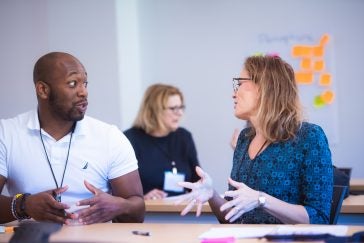 The second #InclusiveSciComm Symposium held at the University of Rhode Island’s Kingston campus in September 2019 was a huge success. The three-day symposium expanded in its second year to include more concurrent sessions, two keynote speakers, a poster session, guided self-care breaks, a live Story Collider mini-show, and plenty of time to network. A conference app conveniently allowed participants to bookmark and rate all the sessions throughout the weekend.
The second #InclusiveSciComm Symposium held at the University of Rhode Island’s Kingston campus in September 2019 was a huge success. The three-day symposium expanded in its second year to include more concurrent sessions, two keynote speakers, a poster session, guided self-care breaks, a live Story Collider mini-show, and plenty of time to network. A conference app conveniently allowed participants to bookmark and rate all the sessions throughout the weekend.
Symposium themes centered on new practices and research, changing systems and structures, and social responsibility and ethics within the large umbrella of science communication. Underpinning those themes was a desire to foster critical dialogue, facilitate new collaborations for research and practice, and build an InclusiveSciComm network. The symposium drew nearly 200 attendees from 27 states and three countries whose work spanned a wide variety of disciplines and career stages, from students and faculty in academia to educators, journalists, filmmakers, community organizers, and more.
The symposium began with a presentation on the state of inclusive science commun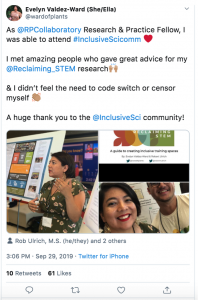 ication, which indicated that leaders in the field felt a personal and moral obligation to make STEM fields more inclusive. These efforts, though, exist in silos all over the country. The InclusiveSciComm Symposium offered a way for practitioners who oftentimes only work within their own professional networks to come together and share their unique experiences, from moments of joy and satisfaction in their local communities to expressing frustration to ongoing systemic challenges.
ication, which indicated that leaders in the field felt a personal and moral obligation to make STEM fields more inclusive. These efforts, though, exist in silos all over the country. The InclusiveSciComm Symposium offered a way for practitioners who oftentimes only work within their own professional networks to come together and share their unique experiences, from moments of joy and satisfaction in their local communities to expressing frustration to ongoing systemic challenges.
One of the main outcomes of this highly intersectional meeting was discovering the commonalities people shared with one another, which allowed for developing strategies and practical tools to further what has already been done to advance the field. Resilience, intention, and authenticity were crucial to building successful initiatives, as was creating supportive networks to lean on during difficult times.
“I loved the openness of the community that was created here as well as the diversity represented,” said Ti’Era Worsley, PhD student in Science Education at the University of North Carolina, Greensboro. “At every conference I am always conscious of who else looks like me there and which different perspectives and people are being represented and recognized. This space felt safe, where I could participate and express my thoughts and ideas and felt that people were genuinely interested in listening to me as well as open to sharing their ideas with me.”
The planning committee this year held an open call for abstracts in order to bring a wide variety of expertise to facilitate transdisciplinary discussion during the concurrent sessions and poster session.
Sessions included:
- “Down with the Scientific Method! Reimagining Teaching the Process of Science in Classrooms and Beyond”
- “From Science to Infographic”
- “Reclaiming STEM: A Guide to Creating Inclusive Training Spaces”
- “Building Community, Catalyzing Change: Science Networks for Civic Engagement”
Exten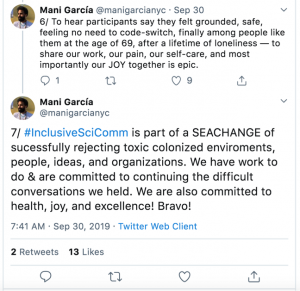 ded breaks between sessions allowed for networking and self care, including stretching and meditation breaks led by planning committee member and yoga instructor Mani García, a doctoral candidate at City University of New York’s John Jay College of Criminal Justice.
ded breaks between sessions allowed for networking and self care, including stretching and meditation breaks led by planning committee member and yoga instructor Mani García, a doctoral candidate at City University of New York’s John Jay College of Criminal Justice.
During the poster session, the hallways were filled with accounts of presenters’ work to increase STEM participation and
inclusivity in their local communities and/or academic fields. Many poster presenters openly asked for suggestions to improve their work, which attendees re
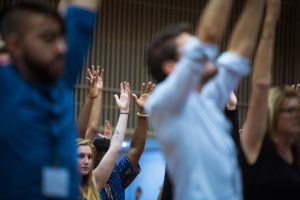
adily provided on sticky notes on their posters. Presenters overall were happy to openly share their presentations and work with other attendees in order to facilitate more initiatives and learning opportunities in other settings, like in professional development trainings and classroom environments.
Some of the barriers to more inclusive practices in STEM research, education, and programming that were identified in the sessions included a lack of funding, time, and recognition, as well as definitions; some suggested expanding definitions of science communication to include practitioners who would not otherwise see themselves in this field.
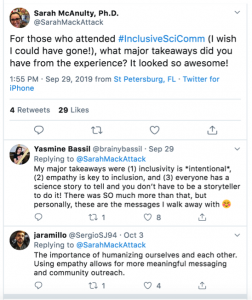 A solution that was highly supported by attendees at the end of the symposium was curating a website of resources that would be representative of the field’s diverse disciplinary influences and the goals each is focused on achieving.
A solution that was highly supported by attendees at the end of the symposium was curating a website of resources that would be representative of the field’s diverse disciplinary influences and the goals each is focused on achieving.
Looking ahead, the national #InclusiveSciComm symposium is now going to happen every two years instead of annually in the hopes that regional meetings will provide ongoing support for initiatives happening around the country.
